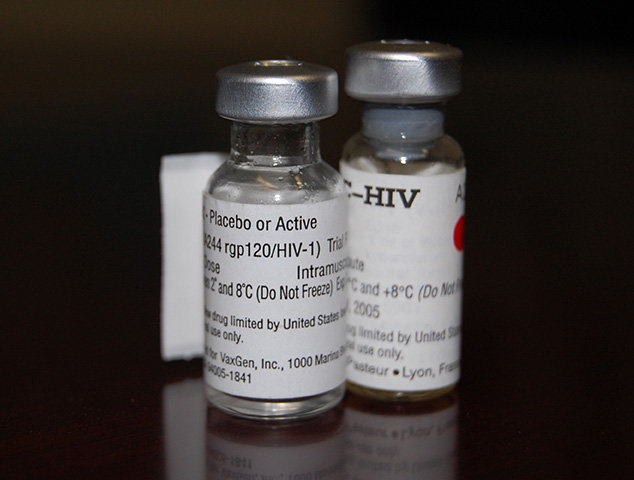AIDSVAX® Program: The RV144 Trial and Related Clinical Trials

The RV144 Trial: Results
In 2009, GSID and our collaborators announced the results of the first vaccine study to reduce the risk of HIV infection in humans. The study represented a major scientific breakthrough, providing the first evidence that development of a safe and effective vaccine was possible. The combination of Sanofi Pasteur's ALVAC vaccine and GSID's AIDSVAX® had demonstrated efficacy of 31.2%. In October 2009, detailed results from the Thai Phase III HIV vaccine clinical trial were presented at the AIDS Vaccine 2009 Conference in Paris, France and published online in The New England Journal of Medicine.
• The New England Journal of Medicine article co-authored by Dr. Donald Francis is available here.
• At the AIDS 2009 Conference, Dr. Supachai Rerks-Ngam of the Thailand Ministry of Public Health presented the RV144 trial results, and Col. Michael of the US Military HIV Research Program presented primary and subgroup analysis of the trial.
The RV144 Trial: Response
The results of the RV144 trial were reported on the front pages of newspapers around the world, and they were widely recognized by the global health community as a major event that would re-invigorate the global HIV vaccine community. The following selected quotes are from leaders in the global health and HIV community at the time of the results announcement:
"This is a historic day in the 26-year quest to develop an AIDS vaccine….These results represent the most significant advance in HIV vaccine research to date, and a ray of hope for the more than 2.7 million women, men and children who become newly infected with HIV every year across the globe."
- Alan Bernstein, the executive director of Global HIV Vaccine Enterprise in 2009
"For more than 20 years now, vaccine trials have essentially been failures. Now it's like we were groping down an unlit path, and a door has been opened. We can start asking some very important questions….This is not the endgame. This is the beginning."
- Dr. Anthony S. Fauci, director of the National Institute of Allergy and Infectious Diseases, New York Times
"Today marks a critically important milestone in the fight against AIDS. For the first time, we have proof that a vaccine can provide protection against HIV infection in humans. These results offer new hope that it's possible to develop a highly effective vaccine with the power to break the back of the AIDS pandemic. The scientific community must move with speed and urgency to build upon these findings. To accelerate the pace of progress, it will be essential to expand research striving for incremental improvements on this initial success. This will be a worldwide effort."
- Dr. Tachi Yamada, the president of the Global Health Program at the Bill & Melinda Gates Foundation in 2009
Time Magazine recognized The AIDS Vaccine (AIDSVAX®) by naming it to the list of the Top 50 Best Inventions in 2009.

The RV144 Trial: Background
In March 2008, GSID agreed with VaxGen, Inc. to obtain the rights and physical possession of the manufacturing materials and data associated with AIDSVAX® B/B′ and B/E, the two HIV/AIDS vaccines tested by VaxGen in Phase III clinical trials between 1998 and 2003. The clinical data and specimens related to the VAX003 and VAX004 clinical trials formed the basis of our research program, "A Path to an HIV Vaccine." Along with the remaining intellectual property related to the AIDSVAX vaccines, GSID also assumed the manufacturing sponsorship of AIDSVAX B/E, which was being tested as a component of a prime boost regimen in Thailand.
The RV144 study was sponsored by the United States Surgeon General via the U.S. Army Medical Material Development Activity and financed by the Division of AIDS, National Institute of Allergy and Infectious Diseases (NIAID), National Institutes of Health (NIH) and the U.S. Army Medical Research and Materiel Command, Department of Defense. The RV144 study was designed to determine if the prime boost combination of ALVAC-HIV vCP1512 and AIDSVAX® B/E prevents HIV infection in healthy adult volunteers and/or reduces plasmaviremia and CD4+ T cells on those who become infected.
RV144 was a Phase III clinical trial consisting of 16,000 non-infected adult volunteers from two provinces, Rayong and Chon Buri, both on the coast of Central Thailand. The trial was community-based, randomized, multi-center, double-blind and placebo-controlled. Volunteers were between 18 and 30 years of age and primarily heterosexual, non-injection-drug-using and at low risk of infection.
Enrollment began in 2003 and concluded in December 2005. The vaccination phase of the trial was completed in July 2006. Volunteers received immunizations as follows: four immunizations with ALVAC-HIV vCP1521, "the prime" at 0, 1, 3 and 6 months and two immunizations with AIDSVAX B/E, "the boost," at 3 and 6 months or placebo. Follow-up was for three years following immunization. Results of the RV144 trial are discussed here.
Because RV144 was designed to examine plasma viremia soon after infection, trial collaborators undertook a second study, RV152, to follow infected individuals over a longer period of time. Results of the RV152 trial are discussed here.
Correlates of Protection Studies
While the RV144 results were an inspiring moment, they were just a step along the way to developing a safe and effective HIV vaccine. Following the announcements, GSID supported an international team of collaborators to analyze samples from the RV144 trial participants to look at immune response in the vaccine recipients. The results of the coordinated analysis were announced in September at the AIDS Vaccine 2011 conference in Bangkok, Thailand.
Two key hypotheses were presented. First, antibodies specific to a particular region (V2) of the HIV protein (envelope) correlated with the lowest infection rate among those who were vaccinated. Second, among the vaccine recipients, those with high levels of vaccine-induced plasma IgA had the highest infection rate. These results are unique to the RV144 regimen but give an important lead for vaccine development to build on. Further studies are discussed below.
Related Clinical Trails and Looking Forward
Based on the results of the correlates of protection studies, more research is needed to see if these responses are directly linked to the reduced rate of infection, and if they can be generalized to other types of HIV vaccines or similar vaccines tested against other regional types of HIV (such as the subtype C viruses in southern Africa).
The results of the first follow-up clinical trial (RV152) were also announced in September at the AIDS Vaccine 2011 Conference in Bangkok, Thailand. The RV152 trial was designed as an extended evaluation of the 114 volunteers who received either the vaccine or placebo and became infected with HIV during the RV144 trial. The study determined that there was no difference in disease progression in volunteers who became infected after receiving vaccine compared to those who had received placebo. While these results were expected, they did confirm that the vaccine regimen used in RV144 is safe.
For the descriptions of the ongoing trials using AIDSVAX, please see our Current Trials page.
Additional Resources




